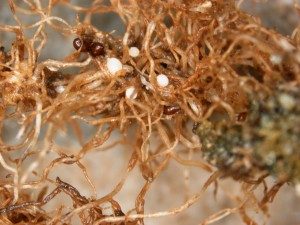What are Nematodes?

Photo Credit: Angela Tenney
Nematodes are very small, slender roundworms in the phylum Nematoda, and are often classified by feeding (trophic) groups such as herbivores, bacterivores, fungivores, predators, omnivores, and unknown/free-living. Nematodes contribute to soil quality by mineralizing soil nutrients to plant-available forms, controlling the populations of other soil organisms, suppressing disease-causing organisms, dispersing microorganisms, and serving as a food source for other organisms.
Do you have an excellent resource that isn’t listed here? Submit it for consideration.
| Title | Source | Resource type and Date | Short Summary / Preview |
|---|---|---|---|
| Purdue Soil Health Education website | Purdue Soil Health Education website | Video
Sep 2017 |
Dr. John Graveel, Purdue Agronomy Department discusses microbiology activity within soils. |
| Nematodes | Purdue University | Extension Fact Sheet
May 2010 |
An Extension publication on nematodes written by Jamal Faghihi and Virginia Ferris. |
| The Living Soil: Nematodes | USDA-NRCS | NRCS Webpage
Not Dated |
An incredible variety of nematodes function at several trophic levels of the soil food web. Some feed on the plants and algae (first trophic level); others are grazers that feed on bacteria and fungi (second trophic level); and some feed on other nematodes (higher trophic levels). |
| Nematodes as Indicators of Soil Health | University of Wisconsin | Extension Webpage
2005 |
The search for easy-to-study organisms with activities and abundance reflective of microbial communities led ecologists to nematodes, a most diverse and successful phylum only one step above microbes in the soil food chain and represented in every soil on earth. |
| Are soil nematodes beneficial or harmful? | Michigan State University | Extension Webpage
Dec 2013 |
The majority of soil nematodes are beneficial to soil health and the environment. |
| Nematodes and cover crops | Michigan State University | University Webpage
Not Dated |
Selecting cover crops for sites infested with plant-parasitic nematodes in Michigan |
| Soybean Cyst Nematode | Purdue University | Extension Webpage
Not Dated |
Soybean cyst nematode (SCN) is a severe problem in Indiana, partly because of the state’s intensive soybean culture. This nematode is capable of making marked yield losses (up to 50%) and has been reported in at least 89 Indiana counties (Figure 1). We estimate that about 45% of fields in Indiana might be infested with SCN. |
| PLFA video protocol | JoVE from University of Wisconsin-Madison Researchers | Video
2017 |
This video protocol explains how phospholipid fatty acid analysis is done and how to interpret the data. |
| Title | Source | Resource type and Date | Short Summary |
|---|---|---|---|
| Role of Nematodes in Soil Health and Their Use as Indicators | The Journal of Nematology | Peer-Reviewed Publication
Dec 2001 |
The composition of nematode communities (plant-parasitic and free-living) may be used as bioindicators of soil health or condition because composition correlates well with nitrogen cycling and decomposition, two critical ecological processes in soil. Improving existing indices or developing alternative indices refined by a greater understanding of the biology of key taxa may enhance the utility of nematodes as bioindicators. |
| Nematodology | Purdue University | Extension Webpage
Not Dated |
Describes the work of the nematode lab at Purdue, now closed and no longer accepting samples. |
| Test for Nematodes at Harvest | Brownfield | News Article with Radio Excerpt
Jul 2019 |
Take nematode samples after mid-July, close to harvest to determine if the pest is in fields. The best time to soil sample is at harvest time, you will have the highest numbers. The best modes of control currently include crop rotation, cover crops, and using resistant varieties. |
Last reviewed 10/25/19